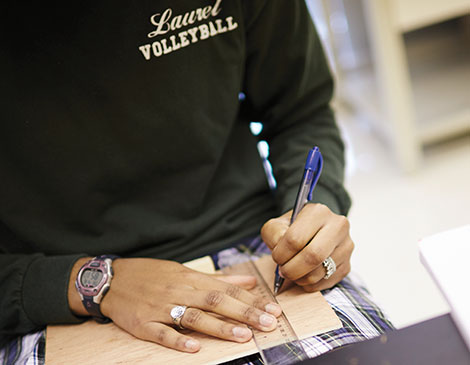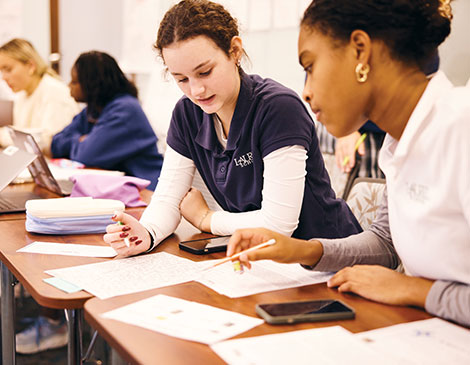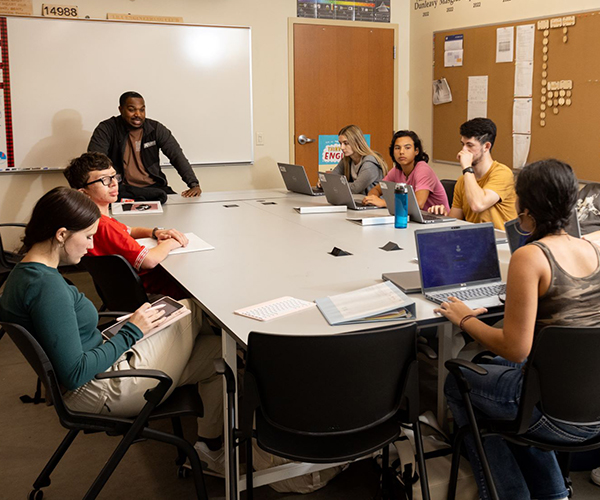Cleveland-Area Schools Assess How GPA Impacts Rankings, Admissions and Overall Student Performance
by Kristen Hampshire | Oct. 7, 2024 | 9:00 AM

Alessandra Minotti, Courtesy Alex Baird, Mock Tuna, Courtesy Molly Keane, Courtesy Anna Maurer
What’s really in this number?
In an academic age where grade inflation is acknowledged, and somewhat anticipated, and there’s “no agreement on what the number means,” how do we realistically look at GPA as a metric, says John Buzzard, campus director at Hershey Montessori School’s Huntsburg Campus.
Today, GPA is a pillar of ivory tower evaluation, and it always has been. It is a pervasive, real and often stressful achievement number that students cling to, parents monitor and colleges review.
“I always try to keep that number up because I like seeing that high number,” says Iannini, 17. “It shows I put hard work into everything I do, and I know that’s the same for everyone around me.”
Before transferring to Lake Catholic as a freshman, Iannini attended a private school that did not assign letter grades or compute GPA.

“Coming in, I was like, ‘I don’t know what this is,’ Iannini says. “I just did my best in my classes. And around sophomore year, people would ask me what my GPA was, and they’d say, ‘Wow that’s really high.’”
Iannini says she wasn’t focused on numbers when they weren’t being calculated. “I like having a GPA now, but I didn’t like it before.”
RELATED: How Cleveland Schools Have Modernized STEM Education
Between 2010 and 2022, an ACT study reported that the average adjusted GPA increased from 3.17 to 3.39 in English, and from 3.02 to 3.32 in math. A 2019 National Association of Educational Progress High School Transcript Study found students were getting better grades than a decade earlier, but they were learning less.
GPA doesn’t necessarily reflect the depth of learning done.
“If you focus on the grade before the learning, you are generally skimming the surface,” says Andrew Cruse, Director of College Guidance at Laurel School. “You’re looking for quick recall and spitting out information, and that is not learning.”
Cruse adds, “If you focus on the learning first and attend to the strategies that allow that to strengthen, the grades will come. This can take some pressure off the numbers and remind students that it is about this sweep of your whole time in high school and how you are going to show up at college.”
It’s not really about the number
“It’s what is in the student, and that is always our first focus,” says Megan Weiskopf, Laurel School’s director of teaching and learning. “That is not to take away from students whose GPAs are through the stratosphere, but we work hard to ensure students and families see this is a small piece of what you bring to a learning community.”

To reduce high school to a number feels small.
“It can help a student be motivated, but in other ways it can be unhealthy for their identity,” says Liz Brainard, a college career advisor who works directly with Lake Catholic and also serves as the director for college advisors across Northeast Ohio in the Lake/Geauga Educational Assistance Foundation.
“Students need to learn failure at a young age and learn that you are not defined by your own achievement.” Cruse acknowledges, “That can be a hard pill to swallow for students and families looking at GPAs. We remind them, the number is not what is ‘under the hood.’”

Buzzard says Hershey Montessori assigns grades and tabulates GPA, but the emphasis is on a narrative via lengthy written assessments from instructors. “The grades we give are shorthand,” he says.
Paula Leigh-Doyle, Hershey Montessori’s head of schools, points out that in the age of artificial intelligence increasingly assuming “concept” tasks, “students need creative muscle,” such as group problem-solving and collaborative skills that
employers demand.
“We use grades, but not as motivators,” she says.
Essentially, even in a whole-child environment, students are cognizant that colleges ask for grades, and they want to bring this piece to the table — and much more.
This is where school profiles come into play.
High schools can provide detailed descriptions of rigor, course offerings and student success.
“Admissions’ job is to understand your territory, your school and how students are being presented,” Cruse says.
“You are never reduced to a number in the college review process, and with the test-optional wave, a holistic review is even more important.” He adds that, “Students are recognizing that their story is about the contributions they’ve made, how they’ve grown, what they’ve exposed themselves to and the interests they’ve fostered.”
At Miami University, the admissions staff will recalculate applicants’ GPAs based on a scale they developed to even out the numbers, in an attempt to create a level playing field, Brainard says, noting that she has not seen the math behind this effort.

Then comes another key point to consider: While focusing on education beyond the numbers, did your student press snooze on senior year?
Brainard describes a senior applying to competitive out-of-state schools, who went into their final year with a knockout GPA. Then, all of a sudden, he checked out.
“His senior schedule was light — he had a couple of study halls, a few art classes, electives and English,” she says. “His attitude was, ‘I want to take it easy this year, I’ve worked really hard.’ But one school wanted to know: ‘Why don’t we see calculus on this schedule?’ They realized he could have gotten into the course, but he chose not to take it.”
The school had called Brainard to inquire about the low-key schedule. “I do not know how typical this is,” she says. “But colleges are actually looking into your senior-year schedule, and they want to see that you are not phoning it in.”
Though extracurricular involvement isn’t defined by a number, it’s a critical factor for admissions that reflects community spirit, engagement and motivation. “Colleges want to see students who are adding value to a campus,” Brainard says.
And we’re realizing more that value isn’t exclusively a numeric thing, as more students are on Individualized Education Plans for modified special education services, or 504 plans with educational modifications.
“This indicates a growing realization of our society that not everyone is the same, thinks the same or approaches the world in the same way,” Buzzard says. “And, in the larger world, there are many talented and successful
individuals that might have had an IEP in school for, say, dyslexia or autism or a processing concern.”
“With the broader understanding of capability and intelligence that we now have, GPA is even less of a clear indicator of academic capability or future success,” Buzzard adds.
Ranking is ‘out’
Who’s No. 1?
“The idea of class rank is disappearing, and it’s very interesting to me that this movement is gaining momentum,” Brainard says, relating that some schools won’t assign letter grades. A friend of hers who teaches at a prestigious boarding school in Massachusetts has told her the academy will not teach A.P. courses because it believes their curriculum is more discerning.
During the pandemic, when SAT and ACT test-optional approaches hit campuses, Buzzard says the shift introduced a fresh perspective to the grading and testing conversation, along with A.P.
“I think we are seeing some pushback on the external demands of schools’ programs,” he says. “I think a lot of schools’ curricula are wanting to speak to themselves, and that is beginning to loosen up some of the standardization of college admissions.”
Buzzard adds, “College and universities are looking for interesting, unique students who fit their goals and profiles, and that isn’t necessarily a student with a perfect GPA.”
So, there really is more to it than just this number created to fit a system. “We are creating artificial numbers that suggest a linear ranking,” Weiskopf says. “There is so much more in play.” In mathematics, the farther out that the decimal point goes, the more “statistically insignificant” that number inevitably gets. But what value lies in that logic when a student is still fixated on every digit, GPA-obsessed, and the ranking continues to hover like a perfection thunderstorm cloud?
Brainard’s husband is a tenured math teacher at Madison High School. Valedictorian and salutatorian are still titles that the district awards. A student who was laser-focused on being No. 1 decided against any College Credit Plus Courses that were not weighted, and dropped band and choir because they do not contribute to her cumulative GPA. She became valedictorian.
What was the gain?
“It’s great to have a goal in mind, but some of the most successful people in the world were not valedictorian,” Brainard says, noting counselors impress this upon students.
Some schools may weigh electives such as music with the A-to-F scale, so that kids are motivated to stick with their passion. Regardless, the point still stands: There’s no consistent standard.
Buzzard says, “GPAs can induce a lot of stress in students, and we want them to see themselves in a larger light and not be fully focused on, ‘Did I get a 3.75 or 3.78,’ and ‘That will make or break my life.’ That kind of energy is not positive. We de-emphasize letters and numbers and greatly emphasize the conversation they are having about knowledge they are gaining.”
That said, “GPA matters when it comes to giving students more post-secondary options,” Brainard says. “You always have options. But a higher GPA can mean you have some options, or all the options.”
Buzzard asks, “Can we really do away with GPA, the idea that GPA is irrelevant? Not at this moment. But we can mitigate this emphasis by reminding every student at every possible turn that it’s not always about the numbers.”

Alex Baird
Junior, St. Edward High School
Living History Club
It’s a mashup of Magic the Gathering, Dungeons & Dragons, action-drama and some Braveheart moves. Picture a couple dozen high schoolers on the campus lawn with foam swords and clubs role-playing a jousting strategy with a fantasy backstory.
This is the Living History club. “I saw the swords made out of foam and the game of constant moving and I was like, ‘This is sick,’” says Baird, who attends the weekly club at 7:45 a.m.
before school starts.
Total Honesty. You must play by the rules and there’s no
faking. If a sword or club grazes the arm, you put the arm behind.

Molly Keane
Junior, Bay Village High School
Bay Village Sailing Team
When Bay Village started its sailing club, Keane was all in. The community of sailors and parents is an invaluable connection. “After practice, it’s like, ‘Where are we going to dinner?’” she says.
Roll with the Swells. “You could be sailing upwind, and the wind shifts 180 degrees,” she says. “You adjust your course and take on what you can.” This “pivot” mindset has served Molly well in school and life.
Showing Up. “You have to be on the water mentally,” Keane says. “You have to know how to respond in your conditions and anticipate what’s next.”

Anna Maurer
Senior, Lakewood High School
The Lakewood Project
Maurer, 17, started playing viola in a traditional orchestra.
Before freshman year, she auditioned for The Lakewood Project, a rock orchestra with electric strings and a full rhythm section. Entering her fourth season with the ensemble, Maurer says the group has been a career-defining outlet that taps her creativity.
A Music World View. “In a traditional orchestra, it’s pretty one-sided,” she says. “In The Lakewood Project, I’ve learned so many ways to be involved with arranging and production.”
A Smash Hit. Maurer composed an arrangement of “Cherub Rock” by The Smashing Pumpkins. “You could tell by the energy in the audience that people loved the music,” she says.
For more updates about Cleveland, sign up for our Cleveland Magazine Daily newsletter, delivered to your inbox six times a week.
Cleveland Magazine is also available in print, publishing 12 times a year with immersive features, helpful guides and beautiful photography and design.
Trending
-
1
-
2
-
3
-
4
-
5










